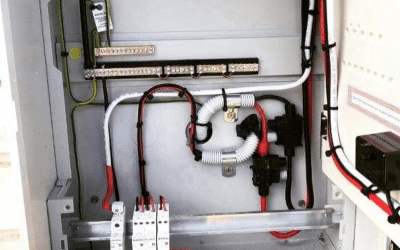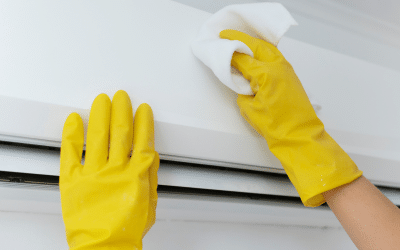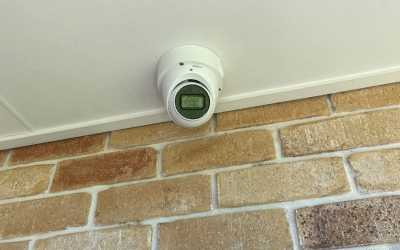Whether at home or work, we feel – and perform – better when our space is clean and tidy. Not only is it better for our health but also for our mental well-being: we all feel more comfortable and at ease when our environment is presentable and well-organised.
However, because we can’t see it, we often don’t pay much attention to the cleanliness of the air in our indoor environments. This is a considerable oversight, as polluted indoor air quality can have a negative impact on our health and overall quality of life – without us even realising it.
With this in mind, in this post, we cover the importance of indoor air quality and offer 5 excellent tips for improving its quality.
What Is The Importance Of Having A Good Indoor Air Quality?
Let’s begin by talking about the importance of having good indoor air quality.
What Is The Importance Of Having Good Indoor Air Quality?
The quality of the air we breathe is so important because it has a direct impact on our overall health. However, seeing as most of us spend approximately 90% of our time inside, it’s crucial that our indoor air is good quality and safe to breathe. If not, we’ll be inhaling dust, chemicals and other pollutants while we work, sleep, eat and relax – diminishing our overall well-being and quality of life.
Fortunately, while we have no influence on the quality of the air outside, aside from choosing to live in a place with cleaner air, we can improve the quality of the air in our indoor spaces.
How Does Poor Indoor Air Quality Affect Your Health?
Poor indoor air quality impacts your health in both the short term and the long term. Short-term health issues caused by poor air quality include the nose, throat, and eye irritation; headaches, coughing, and sneezing; fatigue and chronic sleep issues. This is worsened if you have pre-existing health conditions such as asthma, migraines and other allergies. Long-term, poor indoor air quality can lead to a variety of respiratory diseases, heart disease and lung cancer.
Factors That Affect Indoor Air Quality
Let’s move on to exploring the different factors that affect indoor air quality.
- Dust: Dust is a combination of indoor and outdoor matter, such as soil, pet dander, and dead skin. Along with other airborne particles, it floats in the air and settles on surfaces. Inhaling small amounts of dust can cause sneezing, nasal congestion, and itching in your eyes, ears, and throat. In large concentrations, however, it can cause shortness of breath, chest pain, and sleep problems.
- Mould: Mould in indoor spaces releases airborne microbes that diminish indoor air quality. Mould growth is often caused by excess moisture caused by everyday activities like cooking, showering, and doing laundry, in addition to plumbing issues like leaks and poor drainage. Exposure to mould microbes can cause allergic reactions and respiratory problems, as well as trigger asthma attacks in those with the condition.
- Chemicals: Many common household products, such as cleaning products, aerosols, paints, varnishes, cosmetics – and even some scented candles and incense – contain chemicals that worsen air quality. The worst of these chemicals are Volatile Organic Compounds (VOCs) which can be detrimental to our health in the short and long term. These include:
- Ethylene glycol
- Formaldehyde
- Benzene
- Methylene chloride
- Tetrachloroethylene
- Toluene
- Xylene
- 1,3-butadiene
Additionally, VOCs can be found in some furniture and household fittings. This includes beds, cabinets, carpets, rugs, and flooring. Laminated floors and floating floors, for instance, are often glued together with formaldehyde-based adhesives that can emit VOCs.
- Poor Ventilation: When you have inadequate ventilation, fresh air doesn’t circulate within indoor spaces as frequently, and the various contaminants listed above are allowed to linger longer than normal. Consequently, many of the symptoms we’ll look at in the next section could be the result of poor ventilation.

How Can You Tell If You Have Poor Indoor Air Quality?
Now that we’ve detailed the importance of good indoor air quality and factors that affect air quality, let’s look at several symptoms that indicate that the air in your indoor spaces is poor quality.
Coughing and Difficulty Breathing
Coughing and general difficulty in breathing are some of the most common symptoms of poor indoor air quality. The main culprit in this is a lack of ventilation, as it increases the concentration of harmful particles, like dust, mould, VOCs, and carbon dioxide in the air.
Without sufficient air circulation, fresh oxygen doesn’t have a chance to enter space. Consequently, constantly breathing in contaminated air can result in a persistent cough and finding it hard to catch your breath. Worse, if left unchecked, in the long term, this can lead to significant respiratory problems and other complications that could, ultimately, be fatal.
Sneezing or Allergic Reactions
Sneezing is another common symptom of poor air quality, often alongside watery eyes and an irritated nose and throat. What’s especially interesting about sneezing is that, if we’re not conscious of the quality of our indoor air, we can often be quick to attribute it to other factors, like hay fever. However, if hay season is over, there’s no cat around, etc., poor air quality could be responsible for your sneezing and other allergic reactions.
Skin Dryness and/or Irritation
When bacteria from dust and other air contaminants settle on your skin, they can block the flow of nutrients that keep your skin healthy resulting in dryness and irritation. Not only does this cause, often considerable, discomfort but, as it affects your appearance, it can also diminish your confidence. Not to mention, if you constantly give in to the urge to itch your skin when it’s irritating, which can result in scarring. If you can’t pinpoint your skin condition to other causes, it could be due to a high concentration of airborne pollutants.
Headaches and/or Nausea
If you suffer from persistent, lingering headaches and can’t identify their cause, it could very well be something in the air in your indoor spaces. You can suffer from headaches and nausea from exposure to dust, mould, VOCs, and other airborne pollutants. Headaches can also be the result of too much carbon dioxide, and, in contrast, a lack of oxygen, in the air, from a lack of ventilation. Additionally, if you suffer from migraines, you might see them occur more frequently as a result of poor air quality.
Sleep Problems
When the air quality in your bedroom is poor, it can be difficult to fall asleep. In fact, studies have shown that you’re 60% less likely to enjoy a good sleep in an environment with poor air quality.
This not only makes you restless in the night (which, is pretty irritating, for your partner as well as yourself) as you attempt to fall asleep but leads to an array of problems the next day. This includes fatigue, irritability, difficulty concentrating and recalling facts, and an over-reliance on caffeine and sugar to get through the day.
A lack of sleep can also suppress your immune system, which makes it easier for you to pick up any bugs going around, as well as fall ill in general. Worse, long-term, chronic sleep problems have been linked with high blood pressure, diabetes, strokes, heart disease, and heart attacks.
Dust Buildup
If you notice dust building up the grills in your air filters and vents, this could be the result of poor ventilation – which also makes it highly likely there’s an increased concentration of airborne pollutants. By the same token, a dust buildup elsewhere in your AC or HVAC system could be the reason for the poor ventilation and the visible buildup in the air filters.
Stagnant Air
Another sign of poor air circulation within an indoor space is when the air becomes stagnant. This can result in ordinary smells lingering longer than they should or, worse, unpleasant odours. Such unpleasant smells can come from various sources, including chemical contaminants, mould, pollen, or dust (remember, it’s largely composed of dead matter). There’s also a chance that the bad smell is caused by something blocking your vents, like a significant dust build-up.
Hot and Cold Spots
If you notice uneven temperatures in different places within an indoor space, i.e., hot and cold spots, this is a good sign that air isn’t flowing properly within it. This could indicate issues with your HVAC or AC system such as blocked vents, dirty air filters, or leaks. Subsequently, if the air isn’t circulating properly, it stands to reason that stagnant air isn’t being replaced with fresh air: improving its quality in the process.

5 Highly-Effective Tips to On How to Improve Your Indoor Air Quality
To round off this post, here are 5 potent tips for improving indoor air quality.
Carry Out a Deep Clean
One of the best and, thankfully, easiest way on how to improve your indoor air quality significantly is with a thorough, deep clean.
In the case of cleaning your home, as well as regular cleaning methods like vacuuming carpets and floors, mopping, and dusting surfaces, you’ll also want to give extra attention to areas that you don’t clean as regularly.
For instance, furniture like beds, mattresses, sofas, and curtains are all too often overlooked and can become packed with contaminants. To combat this, put what you can through the wash, or take them to the dry cleaners while vacuuming the rest. Subsequently, some vacuum cleaners come with attachments that are ideal for this task.
Also, be sure to thoroughly clean underneath and behind furniture as dust and other contaminants accumulate there too. When it comes to shelving, remove the items from them and give them a deeper dusting than you usually would. It also doesn’t hurt to give the items from your shelves a bit of a wipe-down, as they would have accumulated dust and grime too.
Now, in the case of an office or other workspace, much of the above advice applies. However, as cleaning is usually handled by contractors, you’ll have to give them special instructions and inform them of your objective of improving your indoor air quality. As a result, they’ll need to pay extra attention to cleaning things like office furniture, curtains, and other upholstery.
Opt for Natural Household Products
While we’re on the subject of cleaning, as mentioned earlier, some household products, like cleaning sprays, deodorants, and cosmetics, contain VOCs, which release airborne contaminants. With that in mind, before carrying out a deep clean, it’s wise to replace your cleaning products – so you don’t release more of the contaminants that you’re trying to clear into the air!
Instead, opt for products that don’t contain VOCs. Fortunately, lots of environmentally friendly and health-conscious companies are committed to tackling the problem of releasing airborne pollutants into the air and manufacturing products that are VOC-free – or at least low-VOC. Looking for products that are labelled as non-toxic, eco-friendly, or natural is a good bet. However, if you want to be more thorough you can look out for chemicals like ethylene glycol, formaldehyde, benzene, and other VOCs listed above.
Improve Ventilation
Letting in more fresh air can help remove airborne contaminants lingering in your indoor air, as well as excess moisture. The simplest way to achieve this is to get in the habit of opening your windows more often. If you live in a cooler environment and don’t fancy getting cold, open your windows when you’re not in the room to allow unpolluted air to circulate.
Naturally, this only applies if you live in an area with relatively clean outside air; if you live by the main road or close to an industrial estate, for example, regularly opening windows could make the problem worse. In such cases, it’s wise to invest in an air filter to combat the problem of both contaminated indoor and outdoor air.
Alternatively, you could install an HVAC or AC system in your home to improve ventilation mechanically. These will systematically push out stagnant, polluted air while replacing it with fresh air. Now, if you already have a ventilation system of some kind and still suspect you have poor air quality, it could do with some maintenance. This could include repairing leaks or clearing vents or filters of built-up dust – both of which would improve its efficiency. Similarly, extractor fans are an excellent way to improve ventilation and prevent mould growth in rooms with a lot of moisture like your kitchen, bathrooms, and laundry room.

Block Outdoor Pollutants from Entering Your Home
Often, poor indoor air quality is caused by outdoor contaminants like pollen and mould. The best way to eliminate them is to not let them into indoor spaces in the first place. Ensuring your doors and windows are properly sealed not only creates a protective barrier against outdoor but also helps regulate the temperature and humidity within the space. Fortunately, home supply or DIY stores sell a variety of inexpensive sealants and fillers for repairing cracks and gaps in window and door frames.
Additionally, some outdoor pollutants can also be transported indoors on our clothing and shoes. To combat this, clean and remove footwear before entering your home and give your outer layers of clothing a good shake. If you have an area between the front door and the house, fit it with shoe racks and coat hooks for storage. That way, you won’t unknowingly bring outdoor contaminants into the main part of your home or workplace.
Control Indoor Humidity And Temperature
Mould and other harmful bacteria thrive in damp, warm environments, so it’s crucial to regulate the humidity and temperature of your indoor spaces to maintain good air quality. As mentioned above, properly sealing doors and windows greatly assist in this and has the added benefit of being easy and inexpensive.
Naturally, an AC system is another common method of controlling your indoor humidity and temperature. However, if you already have one in your home or workplace and still have hot spots in which mould is growing, you may need to look into having it repaired or maintained, as it may not be distributing air properly.
Also, depending on the climate where you live, you could benefit from a humidifier or dehumidifier. It’s best to maintain an indoor humidity of between 30 and 50% – but no more than 60%. While too much humidity can encourage mould growth, in contrast, too little humidity can irritate your nose and throat, make your skin dry and, long term, result in the development of respiratory issues.
Conclusion
So, to sum up:
- Our air quality has a significant impact on our overall health and because we spend around 90% of our time inside, our indoor air needs to be clean.
Factors that affect indoor air quality include:
- dust
- mould microbes
- chemicals: volatile organic compounds (VOCs)
- poor ventilation
- Signs you have poor indoor air quality include:
- coughing
- sneezing
- headaches
- nausea
- dust buildup
- stagnant (bad-smelling) air
- hot and cold spots
- 5 tips for improving your air quality:
- Carry out a deep clean
- Use natural cleaning products (free of VOCs)
- Improve ventilation
- Block outdoor pollutants from entering your home
- Control your indoor temperature and humidity
If you’d like some expert advice on the best ways on how to improve your indoor air quality – such as carrying out maintenance on your HVAC or AC system – contact us to talk it through – and for a free, zero-pressure quote.







